
Types of Food Thickening Agents
Creating a hearty, full-bodied winter soup or plating the perfect slice of blueberry pie all require the same secret ingredient: starch. Starches are available in many different forms, prepared using different cooking techniques, and certain starches should be used for specific recipes. Whether you're creating a roux to make your signature macaroni and cheese, or are unsure of how much malt powder to add to your chocolate shakes, we've got you covered on all of your food thickening agent questions.
Shop All Food Stabilizers, Thickeners, & Preservatives
Use the following links to Iearn more about types of food thickeners:
A food thickener is a thickening agent that increases the viscosity of a liquid mix without interfering with its other properties. Knowing how to thicken food is essential for preparing many recipes; most sauces, gravies, soups, and even desserts are thickened with some kind of starch. Each thickening agent has properties best suited for specific recipes. One of the most commonly used methods for thickening sauces and other recipes is through the gelatinization of starches.
Pure Food Thickening Starches
Pure starches have greater thickening power and add less color to a final dish, making them ideal for sauces, puddings, and fillings. Gluten-free thickeners have become an emerging trend for food allergy-conscious bakeries and restaurants. Thickening starches are particularly important in gluten-free baking because they mimic the "sticky" effects of gluten and create a pleasant texture in baked goods. Luckily, many pure starch and leavening ingredients are naturally gluten-free! Just be sure to check nutrition info for ingredients containing these variations of wheat: barley, durum, faro, malt, Matzoh, oats, rye, seminola, spelt, and wheat (bran, flour, germ, starch, and hydrolyzed protein). Use this food thickeners list to find a starch that will be perfect for your recipe!
How to Store Thickening Agents
The best way to store thickening agents is by keeping them in an air tight container in a cool, dry place. If not promptly used, most thickeners (especially powder) can deteriorate, especially from heat. If they absorb moisture from the air, they can lose their effectiveness. Be sure to check individual labels for storage instructions.
If you attempt to thicken a sauce to put in your gravy boat by simply stirring flour into the simmering liquid, you'll end up with lumps. The starch around each lump of powder expands and forms a gel that prevents granules from separating. Luckily, there are easy methods to help prevent lumpy sauces! They also help eliminate any unpleasant raw-flour taste that can occur if sauce isn't simmered long enough. The following are methods commonly used to prep flour or starch before you use it as a thickener:
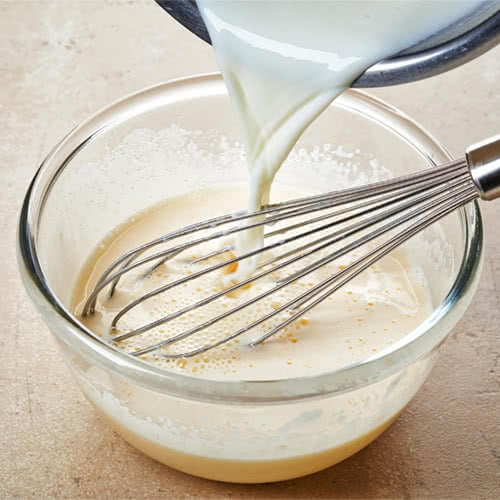
Liaison
Used only for slightly thickening custards or sauces, liaisons are made by tempering 1/3 of your hot mixture / sauce to a stainless steel bowl of whipped egg yolks and cream. Constantly whisk this so the eggs and cream do not curdle. Once homogenous, add the entire contents of the bowl back to the mixture / sauce and keep whisking until the sauce turns slightly thicker. Using the liaison method also gives your sauces a richer, creamier texture and mouthfeel.
- Vegetarian & Gluten-Free

Roux
As a liquid thickening agent, a roux is a perfect way to add viscosity to various soups and sauces, especially four out of the five Mother Sauces used in French cuisine. Equal parts flour and fat are whisked in a hot pan until smooth, and then cooked to either a white, blond, or brown roux depending on desired caramelization and depth. Gluten-free flours can be used in place of the more common flours to offer more options for your gluten-sensitive patrons.
- Vegetarian

Slurry
Using starches such as cornstarch, arrowroot powder, and the like requires more than simply adding the powder to your batch of soup. If added straight to the pot in this way, the starch will quickly clump up and not homogenously disperse throughout your dish. To combat this, you must first make a slurry. In a small bowl, add an equal amount of starch and cold liquid together and smooth out until a paste forms, creating the slurry. Whisk your slurry into the hot, simmering liquid that you wish to thicken and bring to a boil. Keep whisking and boiling simultaneously until there is no longer a starch taste.
- Vegan & Gluten-Free
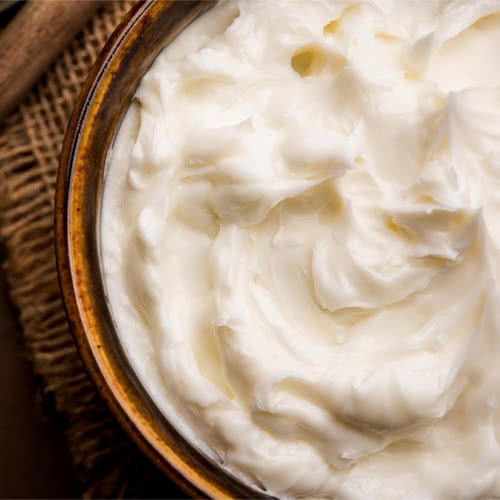
Beurre Manie
Equal parts flour and soft, pliable butter, these two ingredients are kneaded together until every flour particle is coated with the fat, creating a dough ball known as beurre manie. This thickening agent is perfect for adding shine and viscosity to your sauces, soups, and stews.
- Vegetarian
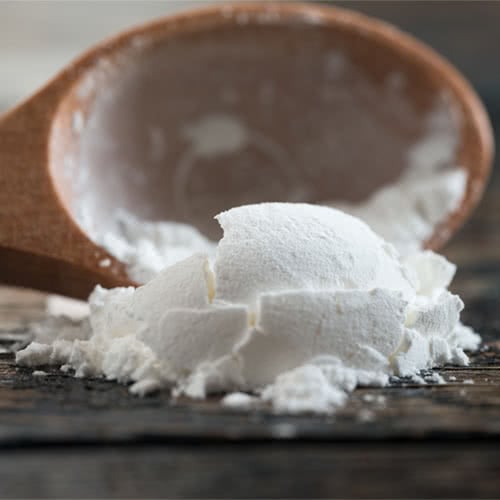
1. Corn Starch
The most common of all the starches, corn starch is derived from corn, making it vegan and gluten-free, as well as transparent and relatively flavorless. This completely versatile starch is used in savory and sweet dishes alike: gelatinizing fruit pie fillings or thickening your hefty, stick-to-your-bones soups.
- Thickens soups, sauces, gravies, and pie fillings
- Coats foods before frying to create a crispy exterior
- Vegan & Gluten-Free
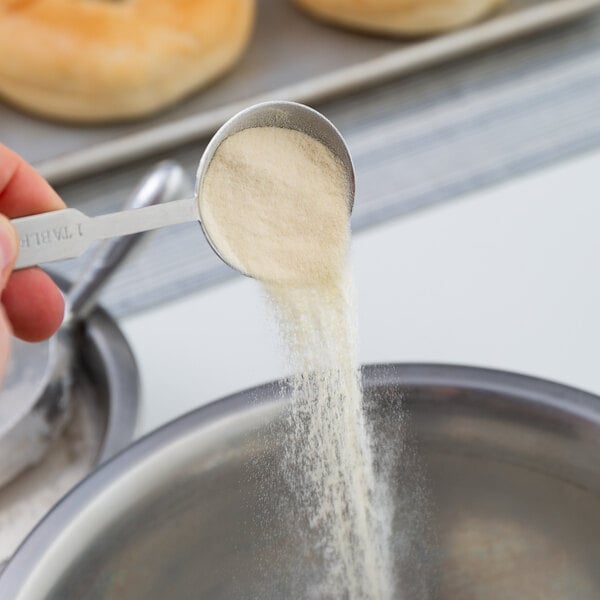
2. Xanthan Gum
As a plant-based, all-purpose thickening agent and stabilizer, xanthan gum is commonly used to thicken sauces and gravies, and it is famous in the gluten-free baking community! Plus, mixing this with yogurt, ice cream, sherbet, and frozen yogurt adds substance and thickness, as well as prevents ice crystals from forming.
- Thickens soups, sauces, gravies, and pie fillings
- Stabilizes ice cream and other frozen treats
- Mimics the elasticity and viscosity of gluten in gluten-free baked goods
- Vegan & Gluten-Free
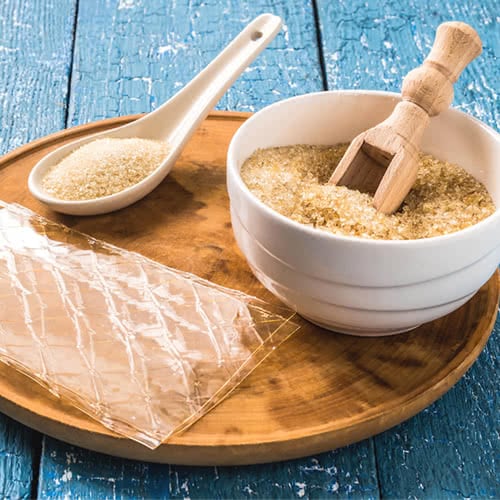
3. Gelatin
Coming in powder or sheet forms, gelatin is made from the collagen that is found in various animal body parts. Gelatin can be used as a stabilizer or texturizer, but it is most commonly used as a thickener for marshmallows, gummy snacks, trifles, aspics, mousse, mirror glazes, panna cotta, and other gelatin desserts.
- Thickens puddings, ice cream, and panna cotta
- Creates a firm texture in gummy candies, marshmallows, and other desserts
- Not recommended for use with pineapple, guava, kiwi, or ginger root
- Gluten-Free

4. Pectin
Pectin is a natural starch that is found in the seeds, rinds, and membranes of citrus fruits, and it is especially high in structured, firmer fruits such as apples and quinces. Unlike gelatin, pectin is not made from animal collagen, meaning it's vegan-friendly. Mainly used for thickening jams, jellies, and marmalades, this natural thickener gels the macerated fruits when combined with acid and sugar and cooked at around 220 degrees Fahrenheit.
- Thickens jams, jellies, marmalades, and preserves
- Vegan & Gluten-Free
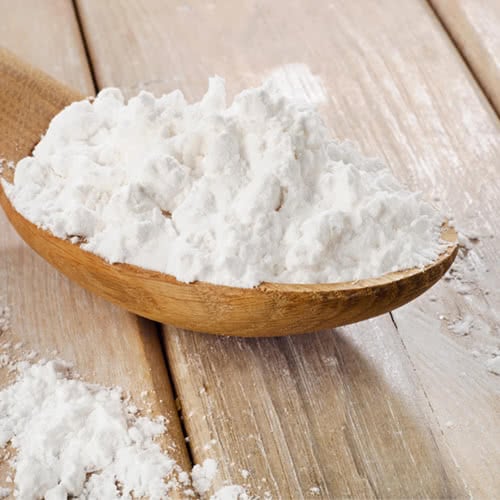
5. Potato Starch
Potato starch is just as its name suggests: starch that is extracted from potatoes. As an amazing thickening and binding agent, it is ever popular in many gluten-free recipes. With a low gelatinizing temperature, relatively colorless, odorless, and tasteless, and a strong binding texture, potato starch is used for cooking and baking applications alike.
- Thickens soups, sauces, gravies, and pie fillings
- Coats foods before frying to create a crispy exterior
- Not recommended for use in dishes with a long cooking or baking time
- Vegan & Gluten-Free
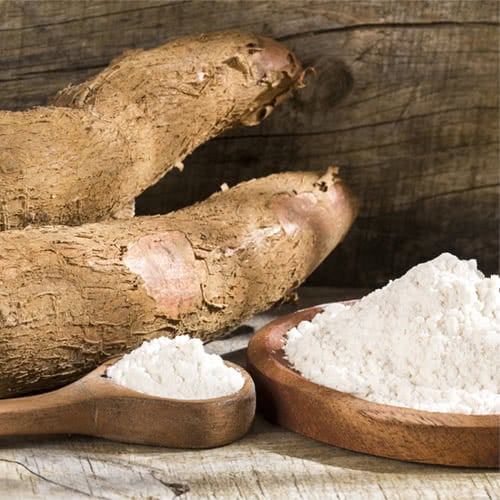
6. Tapioca Starch
Extracted from the cassava plant, tapioca starch is a very fine, starchy, white powder that is a great thickening agent for food. Slightly sweet, tapioca starch is sometimes used in place of cornstarch, potato starch, and even wheat flour in gluten-free baking! Tapioca starch gives baked goods a crispy crust and chewy center, and is superior to arrowroot starch and potato starch.
- Thickens soups, sauces, and desserts
- Creates a crisp, chewy texture in gluten-free baked goods
- Vegan & Gluten-Free

7. Arrowroot
Derived from various tropical plants such as arrowroot plant, tapioca, and cassava, arrowroot powder is a colorless and flavorless thickener that has twice the thickening power of flour, and stands up against acids that normally break down other starches.
- Thickens soups, sauces, gravies, and pie fillings
- Coats foods before frying to create a crispy exterior
- Vegan & Gluten-Free

8. Agar-Agar
Made from red algae, this thickener is a jelly-like substance that is perfect for substitution with gelatin when making vegetarian and vegan foods. Agar-agar, often referred to as "kanten" or "agar", is odorless, flavorless, and colorless, keeping your recipes to their tried-and-true perfection.
- Used in Asian desserts as a plant-based substitute for gelatin in vegan recipes
- Utilized in preserves, jellies, and jams
- Vegan & Gluten-Free
Common leavening agents release gases that form air pockets throughout the dough or batter. As the product bakes, the gases expand and cause the product to rise. The proteins in the dough or batter then set around the air pockets to give products their rise and texture.
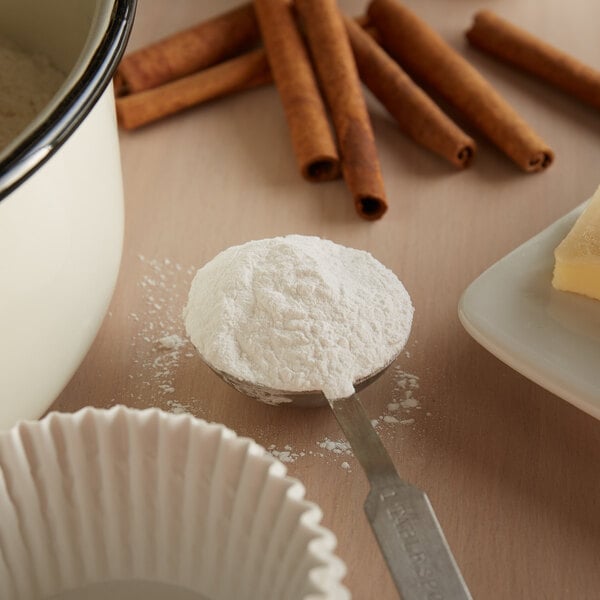
Baking Soda
Also known as sodium bicarbonate, this alkaline compound will release carbon dioxide gas if both an acid and moisture are present. When heated during baking, the carbon dioxide expands to give baked goods their characteristic texture known as "crumb." Heat is not necessary for this reaction to occur; therefore, products made with baking soda must be baked at once to prevent carbon dioxide escaping from batter or dough.
Acids commonly used with baking soda are buttermilk, sour cream, lemon juice, honey, molasses, and fruits high in acid such as citrus.
- Leavening agent in baked goods that include acidic ingredients like buttermilk, cream of tartar, lemon juice, or molasses
- Vegan & Gluten-Free
Prep Note: If more leavening action is needed, add baking powder instead of baking soda. Too much baking soda results in a soapy or bitter taste, and yellow and brown coloring.

Baking Powder
This is a mixture of baking soda and an added acid, such as cream of tartar and/or sodium aluminum sulfate. Baking powder also contains a starch to prevent lumping and to balance chemical reactions. Once baking powder is in contact with liquid, it reacts quickly; therefore, products made with baking powder must be baked soon after the powder is added to prevent carbon dioxide escaping from batter or dough.
- Leavening agent in baked goods with low acidity levels
- Vegan & Gluten-Free

Yeast
Yeast feeds on sugars, producing alcohol and carbon dioxide, the gas that raises a dough to give it the proper texture. This organic leavening agent will take a substantial amount of time to rise, so temperature must be controlled carefully.
- Leavening agent in bread, pizza crusts, and some cakes
- Vegan & Gluten-Free
Here's a list of thickening agents for cooking that are great alternatives to more common starches and leavening agents. Try these less common thickening agents to add unique flavor and texture to your baked goods, beverages, and puddings!

Cocoa Powder
Popular in desserts, many people don't realize cocoa powder is actually a starch despite common belief. Made from the brown powder left after fat (cocoa butter) is removed from cocoa beans, cocoa powder does not contain sweetener or flavoring and is used primarily in baked goods.
- Thickens and adds chocolate flavor to baked goods and desserts
- Vegan & Gluten-Free
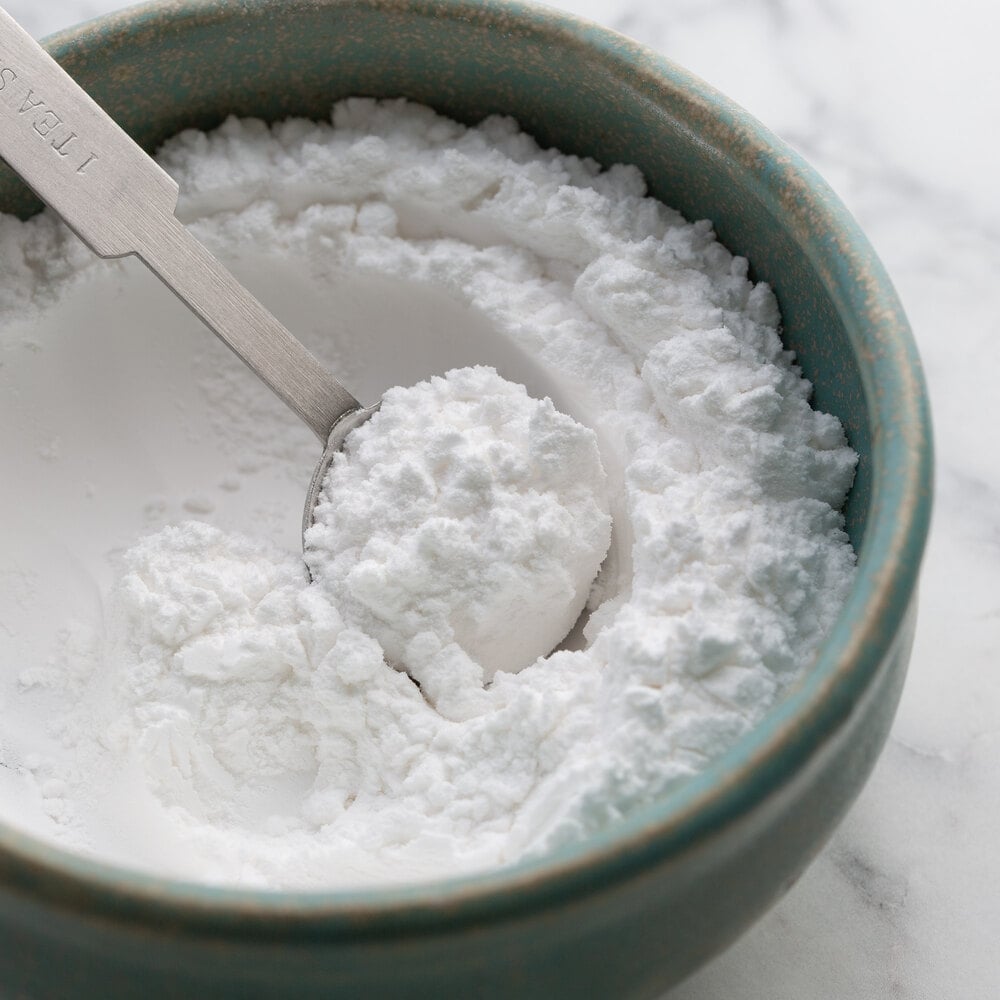
Cream of Tartar
Also known as potassium hydrogen tartrate, this fine white powder is a by-product of the wine-making process forming inside barrels during grape fermentation. Cream of Tartar is commonly used when beating egg whites to increase heat tolerance and volume, making it ideal for meringues and soufflés. It will also help prevent the crystallization of sugar syrups, resulting in creamier candy and frostings.
- Stabilizes whipped cream and egg whites
- Adds creamy texture to candies and frostings
- Vegan & Gluten-Free

Malted Milk Powder
A dry mix of malted barley flour, wheat flour, and powdered milk, malted milk powder is commonly used to thicken milkshakes and baked goods.
- Thickens milkshakes
- Adds umami flavor to baked goods
- Vegetarian
Related Resources

Protecting Your Recipes: Trade Secrets & Patents
Chefs and bartenders alike spend a lot of time in the kitchen or bar working to perfect their recipes. Sometimes, a truly special, totally unique dish or drink is created, and the first thought is, "I wonder how to get a patent for this recipe?" But is it even possible to patent a recipe? And if not, how does one protect their best kitchen secrets? Can I patent a recipe? The simple answer is no. While it is technically possible to obtain a patent on certain recipes , the likelihood and rate of patents being granted for recipes is so low that it is almost pointless to try and obtain one unless you own a chain of restaurants or are looking to franchise your business. The effort required to protect intellectual property, such as a secret recip

Cooking Measurement Conversion
In the chaos of a fast-paced, commercial kitchen, you might not have time to convert measurements and resize your recipes . Whether you're an experienced chef or training new staff, understanding measurement conversions helps you reduce mistakes so you can confidently cook or bake your favorite dishes. This guide contains all the tools needed to accurately measure and convert ingredients, ensuring that your recipes turn out perfectly every time. Shop All Measuring Spoons and Cups Use the following links to convert different cooking measurements: Kitchen Measuring Conversions Kitchen Measurements Chart Abbreviations for Cooking Measurements Liquid Measuring Cups vs Dry
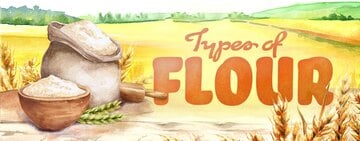
Types of Flour
Flour is the fundamental ingredient of many baked goods - including bread, pastries, pies, and cakes - as well as pasta and pizza dough. However, not all flour is alike. Various factors, such as protein content, how the flour is processed, and the grain, affect how you use it while baking. Whether you own a bakery , cafe, or restaurant, it's imperative to use the best types of flour to produce high-quality food and desserts. We explore the different kinds of flour, their uses, processing considerations, and protein content to help you find the best flour to meet the needs of your establishment. Shop All Flour Use the following links to learn more about different types of flour: Bleached vs Unbleached Flour Different Types of Flour Types of
- Topics 1346
- Industrial 55
- Troubleshooting Guides 21
- Restaurant Management 128
- Bar Management 55
- Catering Tips 35
- Bakery Management 42
- Food Trucks & Concessions 49
- Advertising & Marketing 37
- Eco-Friendly Tips 11
- Facility Layout & Design 41
- Coffee Shop Tips 28
- Installation & Maintenance 51
- Janitorial & Pest Control 30
- Safety & Sanitation 88
- Startup Tips 104
- Menu Design 10
- Kitchen & Cooking Tips 81
- Hospitality Management 23
- Pizza & Sandwich Shop Tips 36
- Smallwares 37
- Food Prep 88
- Tabletop Items 17
- Disposables 22
- Calculators & Tools 6
- Consumables 52
- Warewashing & Laundry 18
- Cooking Equipment 90
- Food Storage & Refrigeration 51
- Beverage Equipment 34
- Office Supplies 6
- Resource Type
- In-Depth Articles272
- Buying Guides296
- How-Tos93
- Product Reviews77


